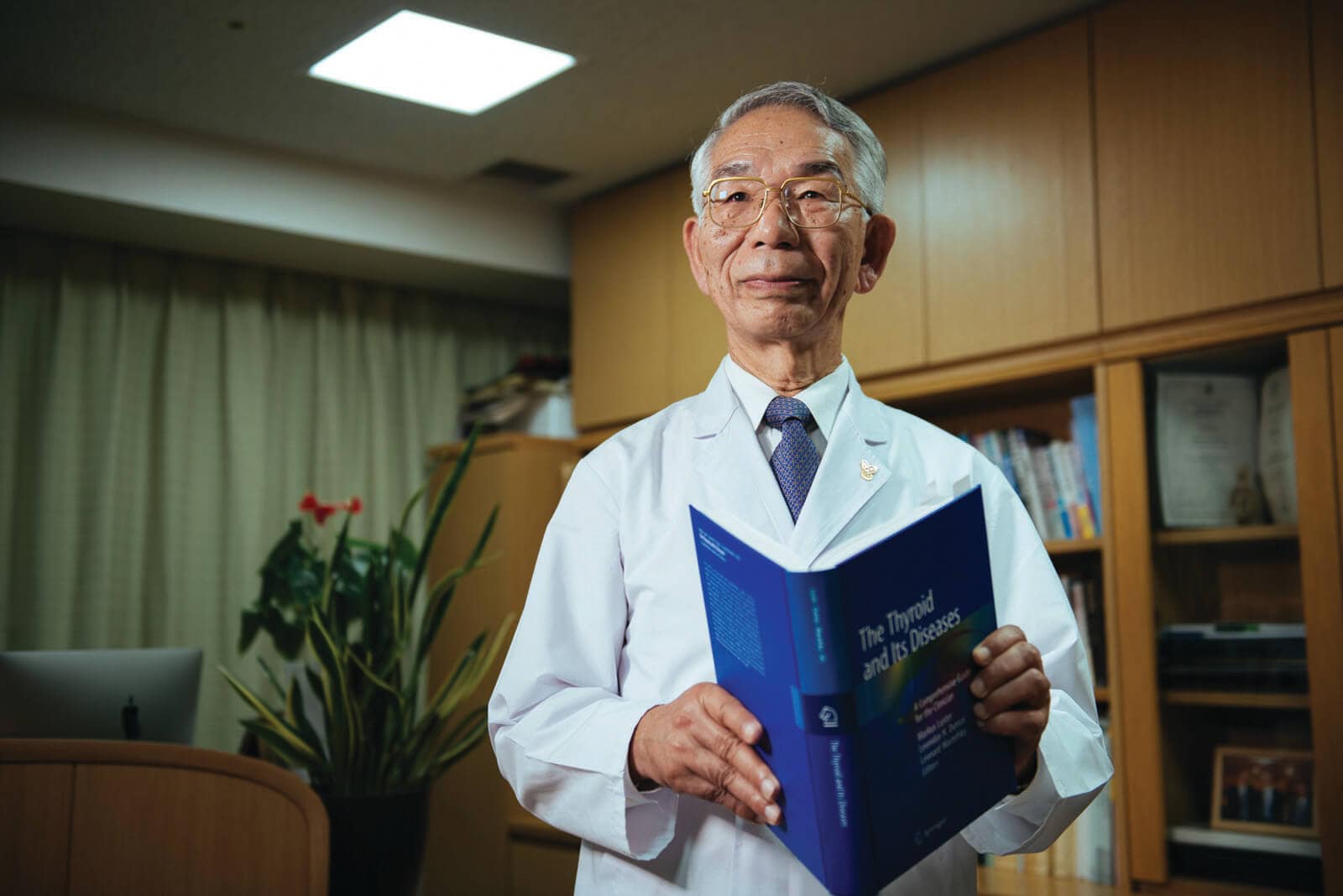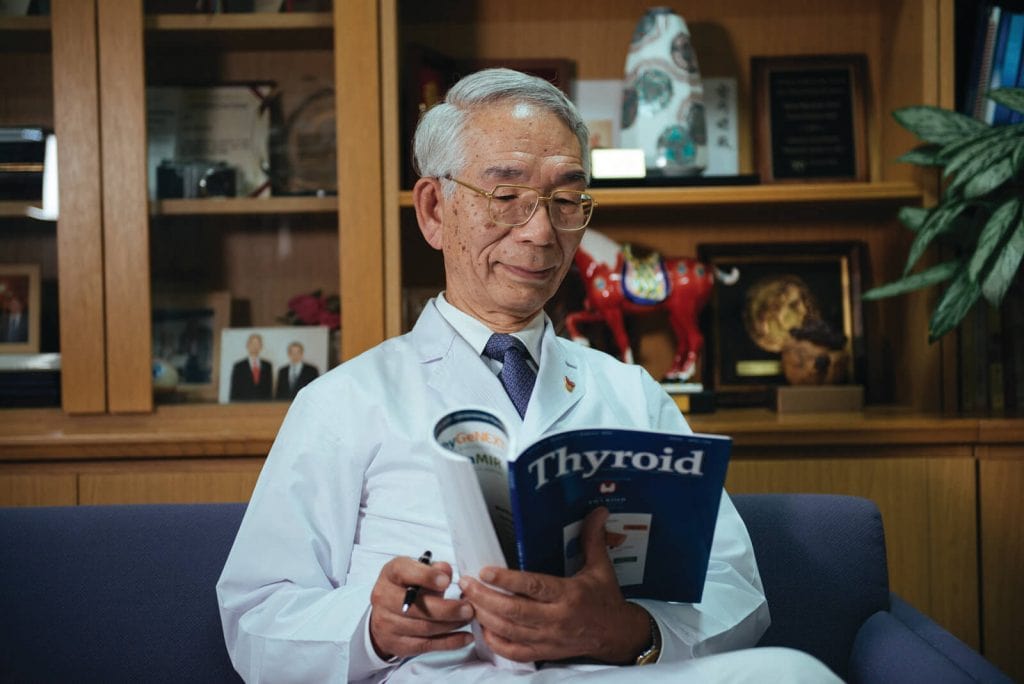Dr Akira Miyauchi is President and Chief Operations Officer of Kuma Hospital, Centre of Excellence in Thyroid Care, Kobe, Japan. In 1993, Dr Miyauchi proposed a clinical trial for patients diagnosed with low-risk papillary micro carcinomas of the thyroid. The trial, which started the same year, allowed patients to choose between immediate surgery – the accepted standard of care – or active surveillance of the disease. In this interview with Roche Diagram magazine, Dr Miyauchi discusses the results of the 26-year study and how it is impacting the way doctors around the world are treating low-risk papillary micro carcinomas of the thyroid.

In 1970, Dr Akira Miyauchi graduated from Japan’s Osaka University Medical School with a single-minded goal: To become a surgeon.
What type of surgeon? Dr Miyauchi was not exactly sure at first. But under the mentorship of Dr Shin-Ichiro Takai, his path became increasingly clear. “Dr Takai was very smart, and I wanted to study under him,” he said. “And he happened to be doing endocrine surgery.”
After earning his MD and PhD, Dr Miyauchi spent the next 49 years distinguishing himself as a leading figure in the field of endocrine surgery. Today, in addition to presiding over Kuma Hospital in Kobe, Japan, he serves as the Chairman of the Asian Association of Endocrine Surgeons and the President-Elect of the International Association of Endocrine Surgeons. But these days he is most widely known for his pioneering research into papillary thyroid cancer (PTC) treatment.
Globally, an estimated 20 million people suffer from thyroid disease. Up to 60% of this population are unaware of their condition.1 Thyroid disease is typically diagnosed by tests that measure three hormones: thyroid-stimulating hormone (TSH), free thyroxine (fT4), and free triiodothyronine (fT3). The TSH test, assessing thyroid function, is typically administered first, followed by a fT4 test if thyroid problems are suspected. Finally, a fT3 test aids in disease differentiation. If thyroid cancer is suspected, an ultrasound is performed, followed, if necessary, by a fine needle aspiration (FNA) biopsy.
For years, the standard recommended treatment after a PTC diagnosis was immediate surgery – even for small tumours posing a limited risk.2 Dr Miyauchi’s research, grounded in a 26-year clinical study at Kuma Hospital, challenged that standard by suggesting that active surveillance is actually the best course of action for patients with PTC tumours less than one centimetre in size without metastasis to the lymph nodes or invasion to the surrounding tissues.
The results of Dr Miyauchi’s study were so compelling that the Japanese Thyroid Tumour Management Guidelines recommended active surveillance as an acceptable management method for low-risk papillary thyroid cancer in 2010. In the following years, other groups, including the American Thyroid Association (ATA), followed suit. The revised Japanese Guidelines published in 2018 now positively recommend active surveillance for low-risk papillary micro carcinoma of the thyroid. Dr Miyauchi’s research is particularly relevant as papillary thyroid cancer continues to be one of the fastest growing cancer diagnoses in the world.
The question is: Why?
A startling trend
In Korea, thyroid cancer incidence rates increased by a factor of 15 between 1993 and 2011.3 They nearly tripled in the United States between 1975 and 2009.4 In spite of this enormous increase in thyroid cancer prevalence, mortality rates for the disease have remained relatively stable.
Such a disparity is not easy to explain, but Dr Miyauchi has a working theory. Modern detection techniques – from ultrasounds with FNA to MRIs and CAT and PET scans – can identify very small tumours that were undetectable 30 years ago. “I think the rising thyroid cancer rates are due to an increase in detection of small papillary thyroid cancer.”
Early detection is a good thing for bad or aggressive cancers, Dr Miyauchi said. But premature or unnecessary surgery for indolent cancers like small papillary thyroid cancer can have serious consequences for patients, such as vocal cord paralysis. So, to determine whether his theory had merit, Dr Miyauchi began looking into autopsy studies of patients who had died of causes unrelated to thyroid cancer. He learned that between 2-6% of the autopsy patients had small papillary thyroid cancer tumours larger than three millimetres that can be easily detected with ultrasound examinations, even though they had died of other causes.2
“This shows that there is likely a high incidence of people in the general population who are living with small papillary thyroid cancer without any symptoms, and without knowing it,” Dr Miyauchi said.
Based on this information, Dr Miyauchi began to doubt whether immediate surgical removal of small PTC tumours was always necessary. A screening study conducted by Dr Koji Takebe at Kagawa Cancer Examination Centre furthered his doubts. In the study, Dr Takebe used ultrasound-guided fine needle aspiration to discover that 3.5% of the subjects – otherwise healthy Japanese women with no disease symptoms – had small papillary thyroid cancer.5 “That number”, Dr Miyauchi said, “was more than 1,000 times higher than the prevalence of clinical thyroid cancer reported in Japanese women at that time.”
Proving his point
How could so many people be living normal, healthy lives, completely unaware that they are living with thyroid cancer?
“I had a hypothesis”, Dr Miyauchi explained, “that most small papillary thyroid cancer will remain small, and that only a small number of cases will ever show progression. The issue is, how can we identify the minority that shows progression?”
The answer? Active surveillance.
This method, which consists of close supervision without immediate surgery, would allow physicians time to determine whether they are dealing with an aggressive tumour or not. According to Dr Miyauchi, such a “wait-and-see” approach would do no harm to patients because of the exceedingly small size of the tumours. If progression does occur, surgery could still be conducted without any loss in efficacy.
Based on this theory, Dr Miyauchi proposed a clinical trial at Kuma Hospital in 1993. Later that year, the study began to test the active surveillance method. At the study’s conclusion, Dr Miyauchi found his hypothesis confirmed. Of the patients involved in the study, only 8% experienced tumour enlargement by three millimetres or more. Furthermore, only 3.4% experienced lymph node metastasis.

“You might think that the appearance of lymph node metastasis indicates a failure of active surveillance,” Dr Miyauchi noted. “But it’s not.” That’s because the standard surgical treatment for patients with small papillary thyroid cancer at presentation is an hemithyroidectomy, in which one side of the thyroid is removed. “This procedure is unlikely to prevent lymph node metastasis in the lateral compartment, so the patients still require a second surgery in the case of metastasis.”6
Pointing out that all of the active surveillance patients in his study who experienced lymph node metastasis were completely cured, Dr Miyauchi said, “I think one surgery is better than two.”
Another major benefit of active surveillance is a lower risk of complications. The incidence of unfavorable events, such as temporary or permanent vocal cord paralysis or permanent hypoparathyroidism, were significantly higher in patients who underwent immediate surgery. “So we believe active surveillance is much better than immediate surgery for the majority of the patients,” Dr Miyauchi said.
A cost-effective alternative
Dr Miyauchi’s groundbreaking research is a prime example of how diagnostics can lead to discoveries that drive superior patient outcomes, better-informed clinical decisions, and significantly lower healthcare costs. The economics of the issue is particularly compelling. Citing research conducted by Carrie Lubitz, Associate Professor of Surgery at Harvard Medical School,7 Dr Miyauchi noted that costs for well-differentiated cancer care in the United States could more than double between 2013 and 2030.
Active surveillance is more affordable than immediate surgery, which becomes especially expensive when factoring in post-operative care. “We found that immediate surgery was 4.1 times more costly than active surveillance,” Dr Miyauchi said. “So I think active surveillance is economically much better for the individual patient, and also for society.”
Be that as it may, adoption of active surveillance is only slowly catching on outside of Japan. Even in the United States, where the ATA has officially accepted active surveillance as a management option for low-risk papillary thyroid cancer, healthcare leaders are proceeding with caution. The ATA is not actively recommending active surveillance yet.
Nevertheless, Dr Miyauchi views the ATA’s acceptance of active surveillance as a significant step in its march toward mainstream acceptance. “They understand that it can be an alternative to immediate surgery for this type of cancer. Once those guidelines were published, many doctors throughout the world became more interested in active surveillance.”
Still, Dr Miyauchi expects an uphill battle. He understands that, particularly when it comes to cancer, both physicians and patients are reluctant to embrace a ‘less is more’ approach to treatment. “There are still many hesitations, which is normal,” he said.
Meanwhile, he will continue to use his platform at Kuma Hospital to advocate for active surveillance, which he firmly believes is better for patients, and better for the world at large. “At the present time, the number one issue for me is advocating for the implementation of active surveillance in as many countries as possible”
References:
1Thyroid Foundation of Canada website. 2018. About Thyroid Disease.
2Ito, Y et al. 2018. Thyroid. Insights into the Management of Papillary Microcarcinoma of the Thyroid.Hyeong.
3Hyeong, S et al. 2014. New England Journal of Medicine. 371:1765-1767.
4Davies L, Welch HG. 2014. JAMA Otolaryngol Head Neck Surg. 140(4):317-22.
5Takebe K, Date M, Yamamoto Y et al. 1994. Mass screening for thyroid cancer with ultrasonography.
6Miyauchi A. 2016. Clinical Trials of Active Surveillance of Papillary Microcarcinoma of the Thyroid. World journal of surgery.
7Lubitz, CC et al. 2004. Cancer. 120(9) 1345-52.














